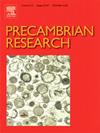热南极地壳中元古代快速盆地形成的自生钛矿约束
IF 3.2
2区 地球科学
Q2 GEOSCIENCES, MULTIDISCIPLINARY
引用次数: 0
摘要
从冰川不稳定岩中提取的碎屑锆石、两代钛矿和自生绢云母的年代学数据为研究南极洲东部的冰下盆地提供了新的视角。盆地形成于中元古代晚期,成岩作用与下伏基底岩麻粒岩相变质作用相吻合。根据前人的研究,我们认为该盆地是一个裂谷层序形成的,但我们扩展了这一模式,提出裂谷与中元古代造山运动直接相关,上地壳伸展与中下地壳韧性流动相结合。盆地碎屑主要来源于约1180 ~ 1160 Ma的富长英质岩浆甲壳。在绿泥石测温和自生钛矿年代学的支持下,失稳岩的自生矿物学表明,在随后的大约5000万至7000万年中,碎屑被深埋并经历了低级变质作用(~ 300°C)。绢云母年龄补充了锆石和钛矿数据,揭示了该盆地在很大程度上未受寒武纪构造活动的影响,这意味着它位于热力学稳定的地壳中,地理上远离冈瓦纳印澳南极主要缝合线。该研究证明了自生和碎屑矿物地质年代学在约束沉积盆地形成时代以及联系地壳深部和近地表过程方面的作用。本文章由计算机程序翻译,如有差异,请以英文原文为准。

Authigenic titanite constraints on fast Mesoproterozoic basin formation in hot Antarctic crust
Geochronological data from detrital zircon, two generations of titanite, and authigenic sericite in glacial erratics transported to the Bunger Hills provide new insights into a deep subglacial basin in East Antarctica. Basin formation occurred during the late Mesoproterozoic, with diagenesis coinciding with granulite facies metamorphism in the underlying basement rocks. In line with previous studies, we interpret this basin to have formed as a rift sequence, but we extend this model by proposing that rifting was directly associated with Mesoproterozoic orogenesis, and that upper crustal extension was coupled with mid–lower-crustal ductile flow. The basin detritus was primarily sourced from a felsic magmatic-rich carapace emplaced at ca. 1180–1160 Ma. The authigenic mineralogy of the erratics, supported by chlorite thermometry and authigenic titanite geochronology, suggests that within the ensuing ca. 50–70 million years, the detritus was buried deeply and subjected to low-grade metamorphism (∼300 °C). Sericite ages complement the zircon and titanite dataset and reveal that the basin was largely unaffected by Cambrian tectonism, meaning that it was situated in thermomechanically stable crust and geographically distant to the major Gondwanan Indo–Australo–Antarctic suture. This study demonstrates the utility of coupled authigenic and detrital mineral geochronology in constraining sedimentary basin formation ages, and linking deep-crustal and near-surface processes.
求助全文
通过发布文献求助,成功后即可免费获取论文全文。
去求助
来源期刊

Precambrian Research
地学-地球科学综合
CiteScore
7.20
自引率
28.90%
发文量
325
审稿时长
12 months
期刊介绍:
Precambrian Research publishes studies on all aspects of the early stages of the composition, structure and evolution of the Earth and its planetary neighbours. With a focus on process-oriented and comparative studies, it covers, but is not restricted to, subjects such as:
(1) Chemical, biological, biochemical and cosmochemical evolution; the origin of life; the evolution of the oceans and atmosphere; the early fossil record; palaeobiology;
(2) Geochronology and isotope and elemental geochemistry;
(3) Precambrian mineral deposits;
(4) Geophysical aspects of the early Earth and Precambrian terrains;
(5) Nature, formation and evolution of the Precambrian lithosphere and mantle including magmatic, depositional, metamorphic and tectonic processes.
In addition, the editors particularly welcome integrated process-oriented studies that involve a combination of the above fields and comparative studies that demonstrate the effect of Precambrian evolution on Phanerozoic earth system processes.
Regional and localised studies of Precambrian phenomena are considered appropriate only when the detail and quality allow illustration of a wider process, or when significant gaps in basic knowledge of a particular area can be filled.
 求助内容:
求助内容: 应助结果提醒方式:
应助结果提醒方式:


